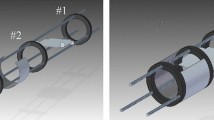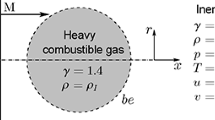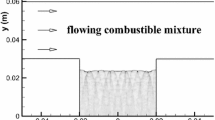Abstract
The effect of the wall contours in an axisymmetric tube on the transition from the shock wave to the detonation wave is studied numerically. Qualitative features and quantitative characteristics of the detonation initiation mechanism realized in a tube with a parabolic segment of the wall contour and conical expansion are found. The calculated results are presented in the form of “detonation curves” (angle of inclination of the contoured segment versus the Mach number of the initial shock wave) for various levels of tube blockage ratio.
Similar content being viewed by others
References
V. A. Levin, V. V. Markov, T. A. Zhuravskaya, and S. F. Osinkin, “Nonlinear processes in initiation and propagation of gas detonation,” Tr. MIAN, 251, 200–214 (2005).
A. A. Vasil’ev, “Estimation of the critical initiation energy for ignition and detonation in gaseous mixtures,” in: G. Roy, S. Frolov, and J. Shepherd (eds.), Application of Detonation to Propulsion, Torus Press, Moscow (2004), pp. 49–53.
E. S. Oran and V. N. Gamezo, “Origins of the deflagration-to-detonation transition in gas-phase combustion,” Combust. Flame, 148, 4–47 (2007).
Ya. B. Zel’dovich and A. S. Kompaneets, Theory of Detonation, Academic Press, New York (1960).
S. M. Frolov, “Initiation of strong reactive shocks and detonation by traveling ignition pulses,” J. Loss Prevent., 19, Nos. 2–3, 238–244 (2005).
I. Semenov, S. Frolov, V. Markov, and P. Utkin, “Shock-to-detonation transition in tubes with shaped obstacles,” in: G. Roy, S. Frolov, and J. Sinibaldi (eds.), Pulsed and Continuous Detonations, Torus Press, Moscow (2006), pp. 159–169.
S. M. Frolov, I. V. Semenov, P. V. Komissarov, P. S. Utkin, and V. V. Markov, “Reduction of the deflagration-to-detonation transition distance and time in a tube with regular shaped obstacles,” Dokl. Phys. Chem., 415, Part 2, 209–213 (2007).
A. A. Vasil’ev, “Optimization of accelerators of deflagration-to-detonation transition,” in: G. Roy, S. Frolov, R. Santoro, and S. Tsyganov (eds.), Confined Detonations and Pulse Detonation Engines, Torus Press, Moscow (2003), pp. 41–48.
O. Peraldi, R. Knystautas, and J. H. Lee, “Criteria for transition to detonation in tubes,” in: Proc. of 21st Int. Symp. on Combustion, The Combustion Inst., Pittsburgh (1986), pp. 1629–1637.
V. M. Gamezo, T. Ogawa, and E. S. Oran, “Numerical simulations of flame propagation and DDT in obstructed channels filled with hydrogen-air mixture,” Proc. Combustion Inst., 31, No. 2, 2463–2471 (2007).
A. A. Vasil’ev, “Specific features of detonation application in propulsion,” in: S. M. Frolov (ed.), Pulsed Detonation Engines [in Russian], Torus Press, Moscow (2006), pp. 129–158.
S. M. Frolov, V. S. Aksenov, and V. Ya. Basevich, “Reduction of the pre-detonation region in a droplet explosive medium by combined methods,” Dokl. Ross. Akad. Nauk, 401, No. 2, 1–4 (2005).
S. M. Frolov, V. S. Aksenov, and I. O. Shamshin, “Detonation propagation through U-bends,” Nonequilibr. Proc., 1, 348–364 (2005).
I. V. Semenov, P. S. Utkin, and V. V. Markov, “Numerical simulations of two-dimensional detonation flows on multiprocessor computational systems,” Vychisl. Metody Program., 9, 119–128 (2008).
T. V. Bazhenova and L. G. Gvozdeva, Unsteady Interaction of Shock Waves [in Russian], Nauka, Moscow (1977).
Author information
Authors and Affiliations
Corresponding author
Additional information
__________
Translated from Fizika Goreniya i Vzryva, Vol. 45, No. 6, pp. 73–81, November–December, 2009.
Rights and permissions
About this article
Cite this article
Semenov, I.V., Utkin, P.S. & Markov, V.V. Numerical simulation of detonation initiation in a contoured tube. Combust Explos Shock Waves 45, 700–707 (2009). https://doi.org/10.1007/s10573-009-0087-4
Received:
Published:
Issue Date:
DOI: https://doi.org/10.1007/s10573-009-0087-4




